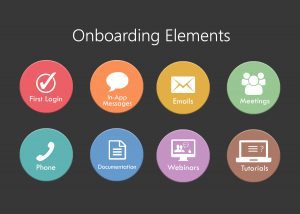All images in this post have been created by the Strikedeck team.

The Onboarding Premise
The value of effective onboarding is well established, especially since poor onboarding has been proven to have a severely negative impact on a business. Potential customers become fatigued by your product from the beginning if they are unable to gain value from your offering in short order. Onboarding is straightforward in concept; get your product set up correctly to meet your customers’ needs, and teach them the basics so that they can work with it on their own. Despite this simple premise, the process can be complicated, and implementation challenging. In the world of software at scale, it’s impossible to hand hold every new user through the onboarding process. The solution: think about who the different types of users are, what their goals are when they get into the product, and optimize your onboarding processes around those needs.
The First Session
The first onboarding session and login experience your customer has with your product sets the tone for your relationship. Therefore, it’s critical to get operations off on the right foot. In your first session working with their instance, make sure you understand the success criteria of not only your stakeholder, but also their manager. Without this, you will not be able to establish value of the product throughout the customer lifecycle. It’s also key to discuss use cases within the product. This will help you understand which use cases can be implemented in short order to highlight quick wins and reinforce the customer belief in the product. It’s good to set realistic, but still impressive, expectations with the customer in the first onboarding session. For example, determine how much effort to learn and implement the product will be required from their side. Pin down the number of meetings and calls it will take, and the results they can expect.
Most of the time, the primary cause for churn is mismanagement of expectations. If you set them too low, the customer may feel underwhelmed. If you set them too high, overpromise and underdeliver, you may find your product swiftly put aside to make room for your competition. Instead, liaison with the Sales department to find out which features were actively pitched, and which aspects garnered the most interest. Then, focus on implementing those first. The first login experience should highlight the key features that will get the customer going. If your CS team never misses a beat, then your onboarding will flow smoothly and naturally. If the experience is confusing or overwhelming, it will put more pressure on the Customer Success team to demonstrate and establish usefulness of the product.

After the First Session
Figure out what constitutes initial success versus customer lifetime value after the first session. The use cases gathered during the first session will come in handy when planning initial success goals. If the time to initial success is too long, you risk losing the customers interest and you will see a gradual decline in customer usage activity. The goal of the onboarding should go beyond setup & use of the product, with the end goal of sustained value derived over time. Tie your customer communication (in-app messages, email, phone call interactions) during the onboarding cycle to the customer realizing the initial success.
A non-standard practice that we advocate is the collection of customer characteristics during the onboarding process:
• What frequency and type of communication is preferred – email, phone, in-person meetings,
video conferences?
• Which type of content is preferred – documents, email, webinars, online tutorials?
• Are they metrics oriented and/or UI oriented and/or activity driven?
• Do they prefer elaborate or minimalistic guidance?
This will help in planning the customer lifecycle, and maintaining a great relationship.
The 6 Onboarding Scenarios
Let’s look at some of the most common onboarding scenarios that exist:
1.) Free Trial Onboarding: The company offers a free trial (between two and eight weeks long). Establish the decision criteria for the ‘go’ versus ‘no go’ scenarios. The key focus should be: how do we demonstrate enough value that they convert to being paying customers?
2.) High-touch Onboarding: High-tough onboarding is typically used for premium customers. It requires a lot of CSM hours, training sessions, as well as personal touches for such large accounts.
3.) Low-touch Onboarding: SMB customers generally receive LTO. Since there are so many of this level of customer, the onboarding is largely automated through the use of in-app tours, email communication, with phone calls as the last resort.
4.) Admin Onboarding vs. User Onboarding: The onboarding for admins should be high-tough, like that for premium customers. They are the gatekeepers for your success within their organization, and hold the keys for renewals and upsells. Their approval is of paramount importance.
5.) First Time Onboarding vs. New User Onboarding: As new users join, they should receive similar onboarding procedures as their predecessors. Previously created content and walkthroughs should be leveraged to minimize effort expenditure. A helpful piece here is that they will have colleagues to consult in house.
6.) First Time Onboarding vs. New Feature Onboarding: Though new feature onboarding will be less intensive than a full product onboarding, make sure your customers understand the value derived from these additions. Your customers should feel that they are getting increased value from the use of your product, even without their prompting. That way, your competitors never get a chance.
A Winning Strategy
Even though onboarding is an established practice, there’s still no standard definition for a perfectly-onboarded customer. Each product has different criteria for what constitutes a successful onboarding, so a good guideline is to make sure that each customer finds value in your offering. Customize where you can, and automate when possible to speed up the process. You want to leave your customer with the feeling that they made the right decision to go with the product.



